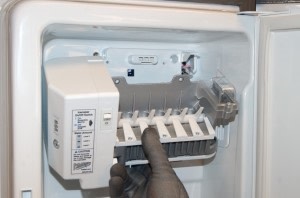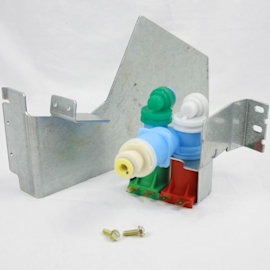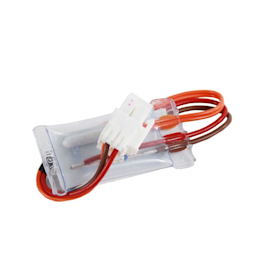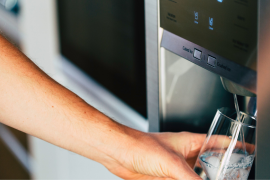Common Refrigerator Ice Maker Problems and Solutions


When you set your mind on being a DIY’er, you seek and find practical solutions to fix problems with home appliances—including your fridge. Although you can’t fix every refrigerator failure, you can likely take steps to resolve the most common refrigerator ice maker problems.
We’ve assembled a list of the most common refrigerator ice maker problems and practical steps that most DIY appliance repair enthusiasts can take to fix the fridge.
Why won’t my ice maker fill with water?
Check refrigerator control settings to make sure the ice maker is turned on. Sometimes a DIY fix is as simple as fixing a control setting.
If the ice maker is turned on, check these issues that may be preventing the ice maker from filling.
Water supply problems
Most refrigerators with ice makers also have a water dispenser. So, you can make sure the refrigerator water supply is okay by dispensing some water.
If you get no water from the water dispenser or your fridge doesn’t have a water dispenser, check the water supply going to your fridge.
Make sure that the refrigerator water supply cut-off valve is open. If it’s shut, open the cut-off valve to restore the water supply to the fridge and ice maker.
If you found the water supply cut-off valve open, check for water flow coming from the water supply line going to your refrigerator. Shut off the water valve and disconnect the water line from the back of the fridge. Place the end of water line in a bucket and briefly open the cut-off valve. If water flows from the end of the water supply line, then you know that your fridge is getting water through the water line.
If you see no water coming the refrigerator water supply line, have a plumber fix the water supply going to your fridge.
When you know that your fridge is getting water through the supply line because the water dispenser works, one of the following problems could be preventing the ice maker from filling.
Frozen fill tube
The #1 cause of ice maker fill problems involves the freezing of water in the fill tube for the ice maker. Defrosting that fill tube typically fixes an ice maker fill problem. To do that, you can use one of these tactics:
Squeeze the fill tube to break up the ice clog. If you can easily reach the ice maker fill tube and it’s made of flexible plastic, squeeze the fill tube with your fingers to break up the ice plug. You may feel the ice crunching as you squeeze the tube. If you’re able to break up the ice, then the ice maker may work properly.
Use a hair dryer to defrost the ice maker fill tube. When you can easily access the fill tube, blow a hair dryer on the fill tube. Use the low heat setting on the hair dryer to avoid melting or damaging any ice maker or refrigerator components. The ice maker may fill properly after you defrost the fill tube in this manner.
Turn the ice maker off for a day. For some French door fridges, turning the ice maker off for 24 hours may allow the fill tube to defrost without even touching it. If the ice maker resumes production after you turn it back on, then you’ve fixed the problem.
As a last resort, you could defrost a frozen ice maker fill tube by safely storing food and unplugging the refrigerator for 8 hours. After restoring power, the ice maker should fill with water because the freeze plug in the ice maker fill tube will be gone.
When the fill tube continues to freezer in your refrigerator, there’s a possibility that you’ll need to schedule a repair appointment to get the problem permanently fixed.
Bad water valve
Sometimes a failed water valve will prevent your ice maker from getting water. After the ice maker dumps the cubes in the ice mold, you should hear the faint buzz of the water valve or water valves opening to fill the ice maker. Many refrigerators have a main water valve that opens to let water into the back of the fridge and then a set of water valves to let water flow to the ice maker or water dispenser.
If the water dispenser isn’t getting water and the ice maker isn’t filling, then the main water valve is likely bad. Here’s a Sears PartsDirect DIY YouTube video that shows how to replace a water valve in a common refrigerator:
You may also need to replace the water valve if the ice maker isn’t filling and your refrigerator doesn’t have a water dispenser.
If you’re unsure whether the water valve is bad, have a Sears Technician visit your home to check the ice maker and water valve.
Why does my ice maker make small cubes?
If you haven’t replaced the water filter in your fridge lately, then a clogged water filter could be restricting water flow and causing the ice maker to produce small ice cubes. Replacing the water filter in this situation should fix the problem. You can find the right filter for your refrigerator using our water filter finder.
If water flow through the water dispenser is normal, then you may be able to adjust the size of ice cubes by changing the ice maker settings. Follow the directions in the owner’s manual for your fridge to increase ice cubes size.
If a clogged filter isn’t causing the small ice cubes and water dispenser flow is low, check the water flow through the supply line going to your fridge as described above. (Shut off the water supply cut-off valve, disconnect the water line and check flow from the water supply line.)
If water flow through the supply line going to your refrigerator is low, have a plumber fix that problem.
If water flows freely through the refrigerator water supply line, then a bad water valve in your refrigerator or a restriction in an internal refrigerator water line may be causing the small ice cubes. You’ll likely need to have a Sears Technician diagnose and repair this type of problem in your refrigerator.
How do I removed jammed ice cubes from my ice maker?
If you hear a constant buzzing and clicking coming from the ice maker in your fridge and you see ice cubes stuck halfway out of the ice mold, you’ll want to act quickly to free up the cubes and avoid damage to the ice maker. Unplug the fridge and pry out the stuck ice cubes using the handle of a wooden spoon or similar tool. Defrost the stuck cubes using a hair dryer on the low setting if necessary.
Once you remove the stuck cubes, you can restore power to the fridge and the ice maker should work normally.
If the ice maker isn’t cycling and you find cubes stuck halfway out of the ice mold, follow the same steps described above to remove the cubes. If the ice maker won’t work after removing the stuck cubes, you may need to replace the icemaker.
Why won’t my ice maker cycle?
When your ice maker seems to be completely dead, you may be able to fix the problem by rebooting the electronic control boards that govern the ice maker. Unplug the refrigerator or shut off the house circuit breaker for the fridge. Wait 5 minutes then restore power and see if ice production resumes. Although this trick doesn’t always work, it’s a simple fix that easy to try.
You may also be able to reset the ice maker by turning it off for 5 minutes using the control described in your owner’s manual then turning the ice maker back on.
If that doesn’t fix the problem, then you can try to test cycle the ice maker in some refrigerators such as LG models. If you have an LG refrigerator, follow the instructions in your owner’s manual or use the instructions from the LG website to reset and test the ice maker.
Why won’t my ice maker produce enough ice?
Low ice production can be caused by an intermittent freezing of the fill tube. If you check the fill tube and it’s frozen up, follow the steps in the above section for troubleshooting a frozen fill tube.
A problem with the freezer temperature or the freezer temperature setting can also cause low ice production. Check the freezer temperature and adjust it to 0-degrees if it isn’t already at that setting.
If the freezer is set to 0-degrees, you can try adjusting the temperature to -1-degrees to increase ice production.
If that doesn’t help, then check door gaskets and other causes that may be preventing the freezer (and the ice compartment in French door models) from cooling properly. Our Troubleshooting “Not Cooling” Problems YouTube video describes how to resolve low temperature issues in common types of refrigerators. Find and resolve the problems causing high freezer temperatures and you’ll likely restore ice production to normal levels in your fridge.
Fixing ice maker problems yourself can save you lots of money—or time if you have extended warranty coverage for your fridge.
Repair guides for bottom-mount refrigerators

How to replace a door gasket in a French-door refrigerator
The door gasket, often called a door seal, seals the gap around the door to keep the cold air in and the warm air out. R…

How to replace a refrigerator water valve
Replace the water valve that feeds water to the ice maker and water dispenser if it no longer controls the flow of water…

How to replace a refrigerator defrost control assembly
Follow these steps to replace the defrost control assembly if your Kenmore or LG French door refrigerator displays an er…
Articles and videos for bottom-mount refrigerators

See how to install the water filter on your GE refrigerator, no matter the filter type or refrigerator style.…

No matter what style Maytag refrigerator you have, we can walk you through replacing the water filter.…

Learn about all the convenient features on our Sears PartsDirect website that make your parts purchases easier.…